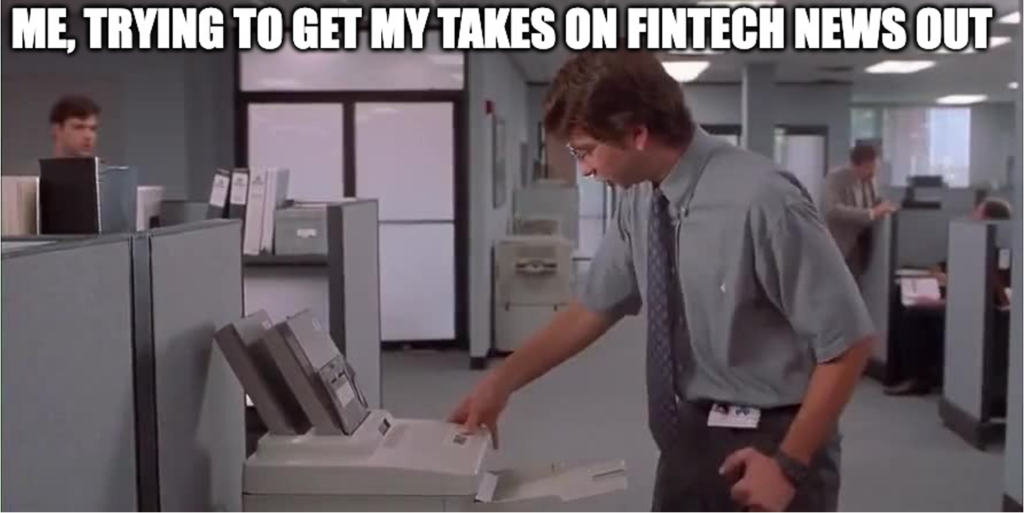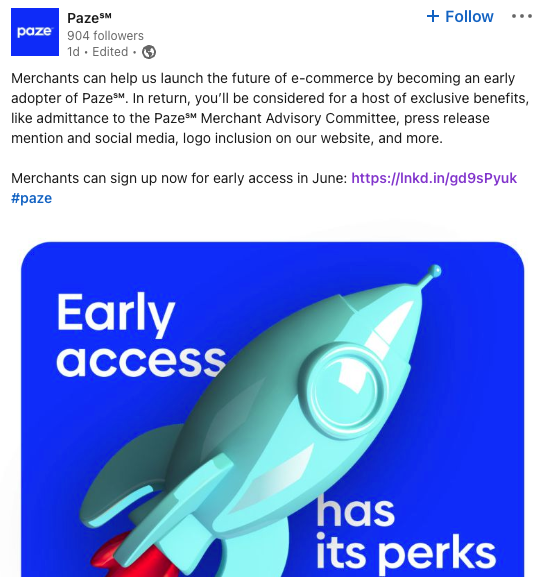21 April 2023 | FinTech
What would you say … you do here?
By Alex Johnson

Today, I’m going to catch up on some fintech news items that I’ve been wanting to share my takes on. And just because I can, how about I pair those takes up with quotes from one of my all-time favorite movies – Office Space?
Let’s do that. Let’s do EXACTLY that!
“Well, I wouldn’t say I’ve been ‘missing it,’ Bob”
What happened?
Apple rolled out a high-yield savings account:
Starting today, Apple Card users can choose to grow their Daily Cash rewards with a Savings account from Goldman Sachs, which offers a high-yield APY of 4.15 percent — a rate that’s more than 10 times the national average. With no fees, no minimum deposits, and no minimum balance requirements, users can easily set up and manage their Savings account directly from Apple Card in Wallet.
So what?
As per usual, this Apple announcement got plenty of press attention and was the subject of a lot of chatter in fintech Twitterland.
I get it. Apple is Apple. They are the only company in the U.S. that has even an outside chance of becoming a super app.
But … this doesn’t seem especially compelling to me.
4.15% is competitive, but it’s not market-leading by any means, particularly when you broaden your lens beyond savings accounts and look at money market and treasury products.
And the user experience is actually kinda terrible!
Apple Wallet, which has become the functional home for all Apple financial products, is a mess. You have a bunch of payment, loyalty, and ID cards all jammed in there. To sign up for a Savings Account, you have to select your Apple credit card, tap on the tiny little settings icon in the top right corner of the screen, and then sign up for Savings.
Apple seems to be operating under the assumption that merely by introducing a new financial product or service, no matter how buried in the OS it is, all of its users will automatically be overcome by FOMO and clamor to get it.
I disagree. I don’t think most Apple users will really feel like they’re “missing it.”
“You know, I’ve never really liked paying bills. I don’t think I’m gonna do that, either.”
What happened?
Walmart sued its credit-card partner, Capital One:
Walmart is suing Capital One, seeking to terminate the companies’ credit-card partnership.
Walmart’s lawsuit, which was filed this week, alleges that Capital One didn’t meet certain terms of the card partnership contract. The case was filed in the Southern District of New York.
Walmart alleged that Capital One didn’t provide the customer service it was obligated to offer, such as replacing lost cards promptly. It also alleged that Capital One didn’t promptly post some transactions and payments to cardholders’ accounts.
So what?
This scene in the movie, in which Peter explains his new life philosophy to an incredulous Joanna, is one of my favorites. She’s a perfect surrogate for the audience – disbelieving, bemused, and slightly impressed … all at the same time.
I’m guessing other merchants feel this way about Walmart.
You’re going to end your partnership with Capital One? Don’t you have a contract?
You’re going to sue them for breaching the contract? Aren’t you worried about how that’s going to look?
You sued your last credit card partner too?!?
Walmart has spent decades vacillating between competing directly with banks and the card networks and collaborating with them. They are the definition of an unreliable partner.
This latest move is being made to accelerate the transition to Walmart’s new neobank/fintech arm, which has been quietly cooking up some new products and services (based on a couple of acquisitions) for the last few years.
We’ll see how long they stick with it.
“What would you say … you do here?”
What happened?
Visa introduced a new service, Visa+, to foster interoperability across different digital payment platforms, starting with … PayPal and Venmo:
Visa announced it is partnering with PayPal and Venmo to pilot Visa+, an innovative service that aims to help individuals move money quickly and securely between different person-to-person (P2P) digital payment apps. Later this year, Venmo and PayPal users in the US will be able to start moving money seamlessly between the two platforms.
Visa+ will not require users to have a Visa card; instead, by setting up a personalized payment address linked to their Venmo or PayPal account, individuals using either app will be able to receive and send payments quickly and securely between the platforms.
So what?
This is a typically smart move by Visa, which continues to incrementally disassociate its core value proposition (operating a global, multi-party payments network) from the specific form factor it is best known for (cards). In addition to PayPal and Venmo, it also announced that Visa+ will be integrating with DailyPay, i2c, TabaPay and Western Union.
But, but, but … we have to talk about PayPal and Venmo!
Visa+ is going to make it seamless for PayPal customers to send money to … [double checks notes] … other PayPal customers.
PayPal owns Venmo! It acquired it through its acquisition of Braintree in 2013. That was 10 years ago! I know stuff moves slowly inside of big companies, but you’re telling me that PayPal couldn’t integrate with Venmo within a decade? That’s insane!
I feel like, somewhere, a PayPal product manager is defending their job, Tom Smykowski-style:
I already told you! I deal with the goddamn customers, so the engineers don’t have to! I have people skills! I am good at dealing with people!
“I must have put a decimal point in the wrong place or something. Shit! I always do that. I always mess up some mundane detail.”
What happened?
Goldman Sachs told investors that it might sell GreenSky:
GreenSky, which facilitates home improvement loans to consumers, was acquired by Goldman in September 2021 in a $2.24 billion stock deal, which closed a year ago.
At the time, Goldman said it expected “significant growth” from combining GreenSky’s products with those offered by its Marcus digital bank.
On Tuesday, Goldman shifted gears.
GreenSky is a “good business” that is performing well, Goldman CEO David Solomon told analysts after the company reported first quarter earnings that sank 19%.
“Given our current strategic priorities, however, we may not be the best long-term holder of this business,” he said, referring to Goldman’s decision to step back from the consumer business.
So what?
Buying Greensky for $2.24 billion, only to sell it less than two years later, is, to quote Peter Gibbons, NOT A MUNDANE DETAIL MICHAEL!
The core problem for Goldman Sachs is that none of the non-investment banking things it has tried to do since 2016 have strategically hung together.
As David Solomon said, GreenSky is a good business. I think that’s true! I think the partnership with Apple and many of the direct-to-consumer banking products that Goldman has launched in recent years are good businesses, too (apart from the amount of money Goldman has spent to stand some of them up).
Most of these bets make sense, individually. There’s just no compounding benefit. It’s not at all like Superman III.
“Look, we want you to express yourself, okay? Now if you feel that the bare minimum is enough, then okay. But some people choose to wear more and we encourage that.”
What happened?
Paze, the new e-commerce digital wallet from Early Warning Services (EWS), is trying to sign up merchant partners:

This has to be the worst pitch in the history of pitches. Imagine it as a conversation:
EWS: Help us launch the future of e-commerce.
Merchant: Why?
EWS: Well, in return for becoming an early adopter, we’ll consider you for some exclusive benefits!
Merchant: You’ll *consider* us?
EWS: Yep!
Merchant: And what are these exclusive benefits we might get access to?
EWS: You’d get to be on our merchant advisory committee, and we’d mention you in our press release and marketing materials!
Merchant: Are you fucking serious?
Merchants already have e-commerce checkout pages that are overburdened with pieces of flair. They don’t need to add one more in order to “express themselves.”
“I stole something.”
“Oh yeah. I guess we all did.”
“No, I stole something else.”
What happened?
LendingTree surveyed 2,044 U.S. consumers about their usage of BNPL:
- 46% of Americans say they’ve used a buy now, pay later service, up from 43% a year ago and 31% the year before that. That includes nearly two-thirds of Gen Zers (65%) and 55% of millennials.
- More than 1 in 4 BNPL users say they use the loans as a bridge to their next paycheck. 27% of BNPL users cite this. Among BNPL users, this rate is even higher for Gen Zers (35%), six-figure earners (32%) and men (32%).
- More than 1 in 5 BNPL users say they’ve used the loans to buy groceries. 21% of users say they’ve done so. Clothing, shoes and accessories are, by far, the most common items users have bought with BNPL at 46%.
- 40% of BNPL users say they’ve paid late on a BNPL purchase. Nearly half (49%) of BNPL users with kids younger than 18 say they’ve paid late, as have 45% of users making $100,000 or more a year.
- More than half of BNPL users (51%) say they’ve regretted financing a purchase with BNPL. Almost two-thirds of Gen Z users (64%) say they’ve done so, as have 59% of men and 58% of those making $100,000 or more a year.
So what?
A few weeks ago, I wrote an essay about the inherent instability of pay-in-4 BNPL as a standalone lending product.
This survey data speaks to that same point.
There is a reason why most lending products that are designed to help consumers bridge gaps in their cash flow charge a fee of some type to the consumer. This is a high-risk population to lend money to, even on a short-term basis.
BNPL providers don’t do that.
Instead, they charge a fee to the merchant for each transaction. Merchants are happy to pay this fee (which tends to be as high or higher than interchange on a credit card) if, and this is important, the merchant is convinced that the BNPL financing makes it more likely for the consumer to buy something and/or causes them to buy more than they otherwise would.
I can see this logic applying to certain types of discretionary purchases – clothing, jewelry, technology – but groceries? No. There is no logical reason for a grocery store to pay BNPL rates to incentivize the purchase of food (literally the opposite of a discretionary purchase) when their customers already have cash, debit cards, and (often) credit cards.
The economics don’t make sense. Someone is being stolen from here.